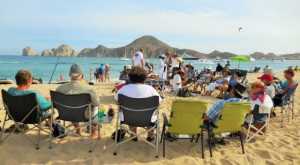
March 27, 2015 – It has been a busy few days since my last blog and the weather has not changed on Baja Sur particularly in the southern loop. Hot, Sunny and Hot! Mid 30s C or low 90s F every day.
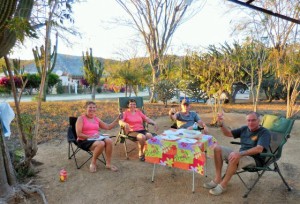
Ciudad Constitucion – Leaving Loreto we headed to Constitucion and Palapa 206. A wonderful drive with spectacular scenery as we climbed the escarpment onto the plateau towards Ciudad Insurgentes. We had a shopping stop at Super Ley then headed for the campground. It was great to see Mike, Bertha, Nigel and Paclo again and hear about Nigel’s racing career. We mustered up a Happy Hour then folks headed for the showers, get on the internet and settle in for dinner. Tomorrow is an early day as we head off for Playa Tecolote. Mark & Katherine found there Baja dog! Coco had only arrived that morning into Palapa 206 and Mike knew it would only be a couple of days before his dogs ran it off. The Chihuahua crossbreed was certainly keen to find a new home and become a Canadian eh!

Tecolote – On our travels we did experience some construction at KM 42, the road was not that bad this time, lots of workers and equipment going which is good to see. We arrived at the beach at 12:30 pm just on time to set up for lunch. It is Saturday so I knew the beach would get busier, even more son on Sunday with such great weather and so close to Easter. I also had a good chat with Lorna who stays on the beach all winter for the most recent updates. Over the next 2 days we lots of folks in the water and enjoying what Tecolote had to offer. Sunday was definitely Cultural Immersion Day with many local Mexicans enjoying the beach as we were. We even had a couple of visits from the military just checking to see that everything was in order, (remember that Mexican order). By Sunday evening calm had returned to the beach, the stars were out and you could only each the surf.

Rancho Verde – Leaving Playa Tecolote behind our next stop was Rancho Verde, not a long drive, but first we made our usual stop in El Triunfo which includes the El Triunfo Café for brunch. Never fast food but always good food. Some folks were keen to see the Piano Museum others the smelter towers and the church. After a good walk about we made our way another 20 KM or 12 Miles down Hwy 1 to Rancho Verde RV Haven. Wifi was not working so well, however the showers were and birds were everywhere. The gang all liked the change of pace and certainly enjoyed the cool mountain air at night (at 1800 FT or 520 MTS), made for great sleeping.
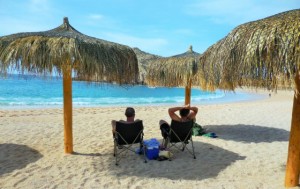
Los Cabos – Day 14 and we were headed for Los Cabos, first we had pour stop at the Tropic of Cancer then our propane stop just outside of San Jose Del Cabo. We arrived at Walmart at the San Lucas Plaza at 11:30 am for shopping and banking and were on our way to the Villa Serena RV Park. The place was humming given it was spring break. A cruise ship was in so the Glass Blowers would be busy, always our first excursion stop at the bottom. Most everyone joined us for dinner at JPs Restaurant (formally Vags), the food excellent, service great and Peter and Joe terrific hosts as always.

Day 2 in Los Cabos and we headed off for our stop at Artesanos. When we returned Mark had an exciting story for us about an encounter with a large Gopher Snake that had slithered from under another RV heading for Coco, yes it must really be warming up on Baja. After that we were off to San Jose Del Cabo and everything it had to offer. I had a meeting with Kay, a Canadian Real Estate Agent living full time here who is helping us find some property for a new park in the area for investors. We had lunch at Shooters, Shelley and staff do a good job for the tourists, a real Canadian hot spot. Later Sylvia, our friends Mark & Katherine joined Lisa and I at Latitude 22, home of No Bad Days for dinner.
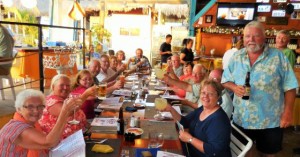

Yesterday we went for our swim at Playa Santa Maria, then dropped some folks off at the Cabo Pariso Mall, afterwards our set out for our Playa Medano Happy Hour. A great way to end our time in Los Cabos.
Next up on the agenda, Hwy 19 and the Los Cerritos Surf Colony.

Did you know?
Contrary to popular belief the California Yellowtail is in the Jack family of fish and is NOT a tuna. A common mistake is confusing Yellowtail with Yellowfin Tuna. The East Coast and Gulf of Mexico Amber Jack is a close cousin. Yellowtail are the most popular target fish for the Southern California sport fishing fleet from San Diego on down the Baja Peninsula, Sea of Cortez and North to Channel Islands at Channel Islands Sport fishing. Although Yellowtail typically run 10 to 20 pounds, they can reach an enormous 79 lbs or more as was caught in 1991 at Alijos Rocks, Baja a popular fishing destination of San Diego’s charter fleet. Yellowtail are a favorite target game fish to catch and eat for many anglers.

In the days before the seiners wreaked their havoc, vast schools of yellowtail moved up from their home waters in Baja to feed for the summer in Southern California waters, and anglers caught them by the thousands along the kelp beds, and around the nearby islands. During the winter months, most of the fish retreated back to the warmer waters off southern Baja, leaving -behind a few “mossbacks” in the local kelp beds to provide some good winter fishing stories.

Today these Pacific schools still migrate up and down the Baja coast, but they are greatly reduced in number and in fish size. Since they grow about three pounds a year, -today a three-and-a-half-foot, 20-pounder is a good one, and a 30-pounder is rare. Unmolested, yellowtail can reach five feet and 50 pounds or more. Other schools of yellowtail make their home exclusively in the Sea of Cortez. In winter, these fish are found in the southern areas from Mulege to La Paz. During summer, they move up to the cool waters of the Midriff Area. In the spring and fall, yellowtail school up for migration, and it is then that the best catches are made. Given their preference, yellowtail swim in water between 67° and 77°, but if bait fish are plentiful they will tolerate waters slightly higher or lower than this ideal range.

Although yellowtail are now scarce in California -waters, there are still lots of them in Baja. Most big yellowtail caught in the Cortez are found down in the reefs 100 to 250 feet deep. They are hooked either on live bait or on iron jigs yo-yoed near the bottom. Heavy tackle, in the 40-pound range, is used to avoid getting cut off on the rocks, and this doesn’t allow the fish to give you its best fight. You will also catch a few large yellowtail near the surface by trolling large, deep running plugs over these same areas, but for large fish in the Cortez you usually have to go down near the bottom. Most of the surface action in the Sea of Cortez is on schools of five- to ten-pounders, which regularly feed near the surface at the north or south ends of islands and off those deep water points of cliffs where current slicks can be seen flowing.

By trolling small, minnow-shaped lures, you will catch plenty of these fish. For us, blue-and-silver or green mackerel five-inch Rebel Fastracs or 11-cm Rapala Magnums are the lures that they seem to favor. Troll the lures in a straight line over their feeding areas at a good speed, maybe six m.p.h.. Along Baja’s Pacific coast, all sizes of yellowtail stay close to the surface in open water while feeding over -shallow reefs, around islands, and along the kelp beds. The center of their Pacific home grounds seems to be the 200-mile stretch of water from Bahia Asunción south to Magdalena Bay. Some of these fish are always present here. However, prevailing sea conditions on the Pacific side are often hazardous for the small boater. “Getting out” to the fishing grounds can only be done when the waves are small and the winds calm. Yellowtail are a nice looking fish. They have a blue or olive back, a broad yellow stripe along the side, a white belly, and a forked yellow tail. Surprise, this great game fish has no teeth! What? No, but their gums are rough.

Regardless of whether you are fishing in the Cortez or the Pacific, yellowtail hooked near the surface put up the stubborn fight for which they’re famous. They strike the lure solidly. On light tackle, they will make a long surface run of 50 to 100 yards. Then they will stay near the surface, and slowly circle your boat. If you let a yellowtail circle in this manner, it will wear itself out fighting line drag and all you have to do is hold on and wait. However, if you try to muscle a green yellowtail toward the boat, it will usually “sound” straight down, and the -situation is reversed. Now the fish takes it easy and you have the hard job of pulling him up from the depths before he cuts you off on the rocks.
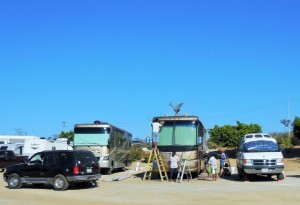
Yellowtail prefer colder waters therefore they are in commonly in the Sea of Cortez in the spring time from February to April. We had a group go fishing on our February 2015 tour in Bahia de Los Angeles with Marcos a local guide and fisherman, they struck gold on Yellowtail.


